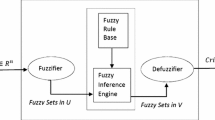Abstract
This paper presents a methodology for tuning the gains of fuzzy proportional-integral controllers where the concept of closed-loop control system performance is explicitly taken into account. The fuzzy controller gains are found by solving a nonlinear constrained optimization problem considering the system’s dynamics described by a nonlinear model and a set of constraints on the controller gains, control actions and outputs. Experimental results collected on a test-bed show the pertinence of using the proposed tuning technique.









Similar content being viewed by others
References
Akaike H (1974) A new look at the statistical model identification. IEEE Trans Automat Control 19(6):716–723
Boubertakh H, Tadjine M, Glorennec PY, Labiod S (2010) Tuning fuzzy pd and pi controllers using reinforcement learning. ISA Trans 49(4):543–551
Chen T, Chen H (1995) Universal approximation to nonlinear operators by neural networks with arbitrary activation functions and its application to dynamical systems. IEEE Trans Neural Netw 6(4):911–917
Chen T, Chen H, wen Liu R (1995) Approximation capability in c(r macr;n) by multilayer feedforward networks and related problems. IEEE Trans Neural Netw 6(1):25–30
Cybenko G (1989) Approximation by superpositions of a sigmoidal function. Math Control Signals Syst (MCSS) 2:303-314
Dong Q, Matsui K, Huang X (2002) Existence and stability of periodic solutions for hopfield neural network equations with periodic input. Nonlinear Anal Theory Methods Appl 49(4):471–479
Feng G (2006) A survey on analysis and design of model-based fuzzy control systems. IEEE Trans Fuzzy Syst 14(5):676–697
Hassibi B, Stork D, Wolff G (1993) Optimal brain surgeon and general network pruning. In: IEEE international conference on neural networks, 1993, vol 1. pp 293–299
Herrera F, Lozano M (2009) Fuzzy evolutionary algorithms and genetic fuzzy systems: a positive collaboration between evolutionary algorithms and fuzzy systems. In: Intelligent systems reference library, vol 1. Springer, Berlin
Hornik K, Stinchcombe M, White H (1989) Multilayer feedforward networks are universal approximators. Neural Netw 2(5):359–366
Lee CC (1990) Fuzzy logic in control systems: fuzzy logic controller. I. IEEE Trans Syst Man Cybern 20:404–418
Leshno M, Lin VY, Pinkus A, Schocken S (1993) Multilayer feedforward networks with a nonpolynomial activation function can approximate any function. Neural Netw 6(6):861–867
Li HX, Gatland HB (1996) Conventional fuzzy control and its enhancement. IEEE Trans Syst Man Cybern Part B Cybern 26(5):791–797
Misir D, Malki HA, Chen GA (1996) A heuristic approach to determine the gains of a fuzzy pid controller. In: Proceedings of the 1996 ACM symposium on applied computing, SAC ’96. ACM, New York, NY, USA, pp 609–613
Murata N, Yoshizawa S, Amari S (1994) Network information criterion-determining the number of hidden units for an artificial neural network model. IEEE Trans Neural Netw 5(6):865–872
Pivonka P (2002) Comparative analysis of fuzzy pi/pd/pid controller based on classical pid controller approach. In: Fuzzy systems, 2002. FUZZ-IEEE ’02. Proceedings of the 2002 IEEE international conference on, vol 1. pp 541–546
Rissanen J (1974) Basis of invariants and canonical forms for linear dynamic systems. Automatica 10(2):175–182
Schrijver A (1986) Theory of linear and integer programming. Wiley, New York
Siegelmann H, Horne B, Giles C (1997) Computational capabilities of recurrent narx neural networks. IEEE Trans Syst Man Cybern Part B Cybern 27(2):208–215
Teoh E, Tan K, Xiang C (2006) Estimating the number of hidden neurons in a feedforward network using the singular value decomposition. IEEE Trans Neural Netw 17(6):1623–1629
Trenn S (2008) Multilayer perceptrons: approximation order and necessary number of hidden units. IEEE Trans Neural Netw 19(5):836-844
Wang HO, Tanaka K, Griffin MF (1996) An approach to fuzzy control of nonlinear systems: stability and design issues. IEEE Trans Fuzzy Syst 4(1):14–23
Acknowledgments
This work has been supported by iCIS-Intelligent Computing in the Internet of Services, Project CENTRO-07-ST24-FEDER-002003.
Author information
Authors and Affiliations
Corresponding author
Rights and permissions
About this article
Cite this article
Gil, P., Lucena, C., Cardoso, A. et al. Fuzzy controllers gains tuning: a constrained nonlinear optimization approach. Neural Comput & Applic 23, 617–624 (2013). https://doi.org/10.1007/s00521-013-1415-x
Received:
Accepted:
Published:
Issue Date:
DOI: https://doi.org/10.1007/s00521-013-1415-x




